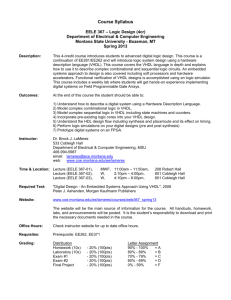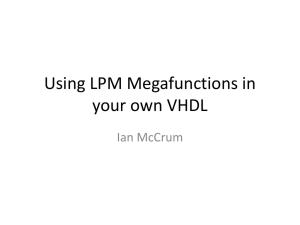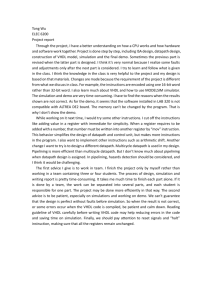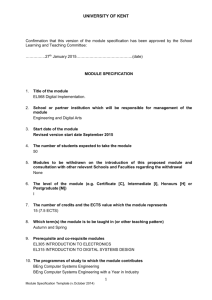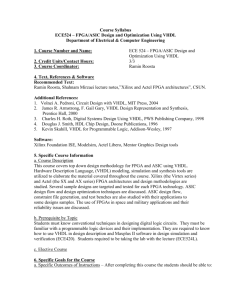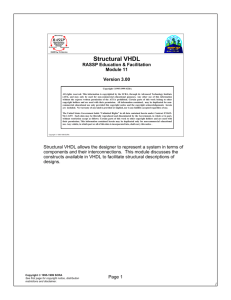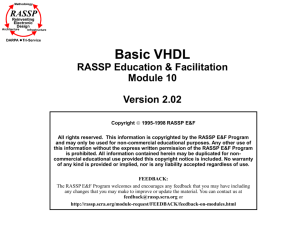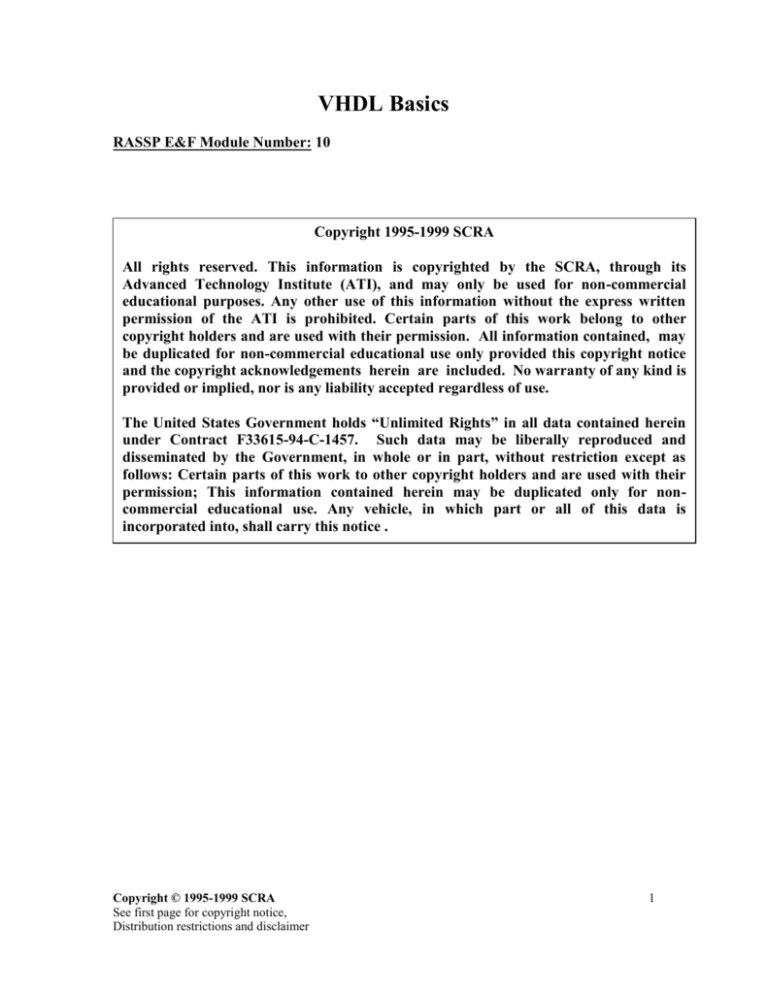
VHDL Basics
RASSP E&F Module Number: 10
Copyright 1995-1999 SCRA
All rights reserved. This information is copyrighted by the SCRA, through its
Advanced Technology Institute (ATI), and may only be used for non-commercial
educational purposes. Any other use of this information without the express written
permission of the ATI is prohibited. Certain parts of this work belong to other
copyright holders and are used with their permission. All information contained, may
be duplicated for non-commercial educational use only provided this copyright notice
and the copyright acknowledgements herein are included. No warranty of any kind is
provided or implied, nor is any liability accepted regardless of use.
The United States Government holds “Unlimited Rights” in all data contained herein
under Contract F33615-94-C-1457. Such data may be liberally reproduced and
disseminated by the Government, in whole or in part, without restriction except as
follows: Certain parts of this work to other copyright holders and are used with their
permission; This information contained herein may be duplicated only for noncommercial educational use. Any vehicle, in which part or all of this data is
incorporated into, shall carry this notice .
Copyright © 1995-1999 SCRA
See first page for copyright notice,
Distribution restrictions and disclaimer
1
Copyright 1995-1999 SCRA
All rights reserved. This information is copyrighted by the SCRA, through its
Advanced Technology Institute (ATI), and may only be used for non-commercial
educational purposes. Any other use of this information without the express written
permission of the ATI is prohibited. Certain parts of this work belong to other
copyright holders and are used with their permission. All information contained, may
be duplicated for non-commercial educational use only provided this copyright notice
and the copyright acknowledgements herein are included. No warranty of any kind is
provided or implied, nor is any liability accepted regardless of use.
The United States Government holds “Unlimited Rights” in all data contained herein
under Contract F33615-94-C-1457. Such data may be liberally reproduced and
disseminated by the Government, in whole or in part, without restriction except as
follows: Certain parts of this work to other copyright holders and are used with their
permission; This information contained herein may be duplicated only for noncommercial educational use. Any vehicle, in which part or all of this data is
incorporated into, shall carry this notice .
See the RASSP Disclaimer file for additional RASSP Disclaimer, Warranty and
Limitation of Liability Information concerning the material, VHDL code and software
developed under the RASSP programs or incorporated in RASSP material.
Copyright © 1995-1999 SCRA
See first page for copyright notice,
Distribution restrictions and disclaimer
2
Copyright © 1995-1999 SCRA
See first page for copyright notice,
Distribution restrictions and disclaimer
3
Abstract: The Basic VHDL module is an introduction to the VHSIC Hardware
Description Language and its fundamental concepts. VHDL is a language
specifically developed to describe digital electronic hardware and its attributes.
VHDL is a flexible language and can be applied to many different design
situations. This language has several key advantages, including technology
independence and a standard language for communication. The module describes
many of the advantages of using VHDL and a short history of the language.
As an introduction to the language, a small design example is shown. This
example shows three different methods of describing the hardware. The module
then introduces three key models of hardware in VHDL: behavior, structure, and
time. These models are important aspects of VHDL and must thoroughly
understood. Several basic VHDL constructs are shown next. The module
describes the basic data types and objects available to the designer. Builtin data
types include integers, floating point numbers, and many others. The designer
also has variable, signal, and constant objects available. The difference between
sequential and concurrent statements is also explained. The basic VHDL design
units, the entity and the architecture, are described in detail. Furthermore, VHDL
supports code reuse through its packages and libraries. Finally, the basic
operators and attributes of the data types and objects are shown.
The Basic VHDL module concludes with a small but comprehensive design
example to illustrate many of the constructs introduced in the earlier sections of
the module. Large examples are provided in the later modules. The focus of this
module is to introduce the basic features of this language and to provide brief
examples of its use.
Module Objectives:
The introduce VHDL such that students can describe and simulate simple digital
circuits using VHDL.
Specific Objectives:
The student shall comprehend and apply:
1) The purpose of VHDL.
2) The overall structure of VHDL
3) The VHDL development and execution sequence
4) The VHDL simulation cycle
5) Basic VHDL object types and declarations
6) The syntax and semantics of basic VHDL sequential statements
7) The syntax and semantics of basic VHDL concurrent statements
8) VHDL modeling techniques for the simulation and evaluation of gate-level
digital circuits.
Prerequisites:
Copyright © 1995-1999 SCRA
See first page for copyright notice,
Distribution restrictions and disclaimer
4
Prerequisite Modules:
Prerequisite Knowledge Aside from Modules:
Working knowledge of digital logic design particularly at the gate level.
Some experience in programming will be helpful.
Syllabus:
1) Introduction
(10 Min.)
2) VHDL Design Example
a) Simple Introductory Design
(15 Min.)
3) VHDL Model Components
a) Entity Declarations
b) Architecture Descriptions
c) Timing Model
(30 Min.)
4) Basic VHDL Constructs
(80 Min.)
a) Data Types
b) Objects
c) Sequential and Concurrent Statements
d) Entity and Architecture Declarations
e) Packages and Libraries
f) Attributes
g) Predefined operators
5) Examples
(20 Min.)
a) Review of Module Material via Comprehensive Examples
6) Summary
(5 Min.)
Infrastructure:
VHDL compiler and simulator, such as Mentor Graphics QuickVHDL or
Veribest VHDL Simulator
Lab Materials:
A laboratory guide and instructions for using the VHDL simulator.
Copyright © 1995-1999 SCRA
See first page for copyright notice,
Distribution restrictions and disclaimer
5




